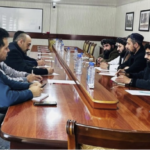Fighting in Afghanistan has turned more violent and bloodier with intensification of political efforts aimed to bring an end to conflict. Over the recent months, there have been daily reports of mass casualties in attacks in every corner of the country. On the one hand, the government largely sidelined from the ongoing peace talks has escalated pressure on militants to prove that it is a key side to the war, and on the other hand, the Taliban have stepped up their violent campaign against Afghan people in order to get more concessions in peace negotiations. In addition to the belligerent sides, Afghan civilians who have nothing to do with the war also suffer heavy casualties on a daily basis. On one side, civilians are the primary victims of government operations and night raids in villages and rural areas, but on the other side, the militants have turned the cities into a living hell for them. Ordinary citizens are not safe from the scourge of war in any part of the country.
On Sunday, a car bomb targeted a National Security Directorate (NDS) compound in Ghazni province, leaving behind over 150 people killed or wounded, mostly civilians. This is the second time over the past two weeks that the rebels carry out such a massive attack in cities, especially in highly populated areas. A huge truck bomb targeted an Afghan National Army’s logistics and engineering compound in Kabul last week, causing over 100 casualties. Many of the victims of both blasts were unfortunately schoolchildren. The Taliban know that such attacks in residential areas surely lead to civilian casualties, yet their thirst for power is as serious as they even don’t care about the lives of innocent children. Same is unfortunately the case with government forces. They also don’t pay attention to civilian lives in counterinsurgency operations. Recently, pro-government forces have caused more civilian casualties compare to the insurgents for the first time in the last 18 years.
The escalation of violence and the behavior of the warring sides amid peace talks erode public’s faith in the political settlement of the conflict, as the ongoing negotiations have brought nothing to them, but massacres and grief. People want peace, but before half of the country’s population is killed. The philosophy of peace is to end bloodshed. If peace parleys cannot help reduce violence, their continuation is counterproductive. The leadership of both sides is safe and having a luxurious life. Taliban leaders are living in air-conditioned homes in Qatar, while Afghan government leaders are staying safe behind blast walls in Kabul, and busy protecting their political future.













